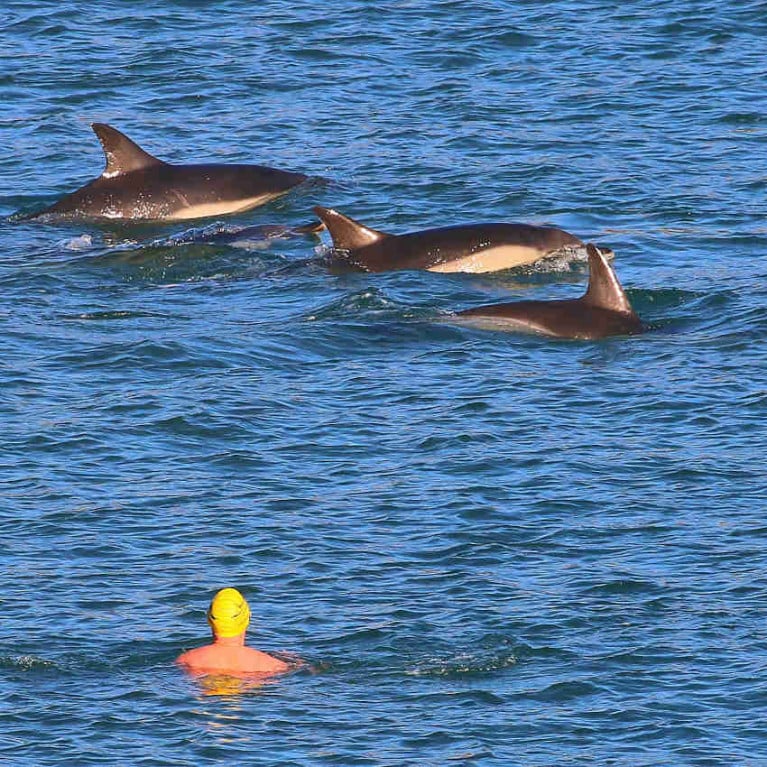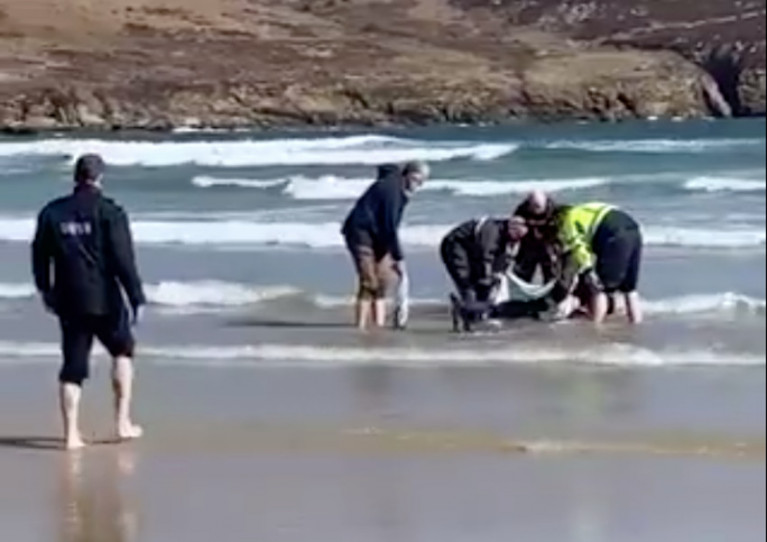Displaying items by tag: Dolphins
Dolphins Delight in Dun Laoghaire Harbour
Dun Laoghaire’s assistant harbour master was quick with the camera when a pod of dolphins paid a visit on Monday morning (8 January).
Dolphins like these are a common sight for boaters in Dublin Bay and beyond.
But it’s a rare treat for these marine wildlife to come so close to shore — and in this case there’s video evidence to prove it, care of RTÉ News.
One commenter on social media suggested the dolphins were in search of herring inshore, as The Sun reports.
The Shannon Estuary’s resident population of bottlenose dolphins could be under threat from plans to transform the area into a green energy hub, a conservation group fears.
Plans revealed last month in the final report of the Shannon Estuary Economic Taskforce envisage the delivery of up to 30GW of power from offshore wind energy projects in the estuary by the year 2015.
But according to the Irish Examiner, the news has prompted concern from the Irish Whale and Dolphin Group (IWDG) for the status of the estuary’s protected and unique dolphins.
Marine wildlife such as dolphins are especially sensitive to noise from human activity, such as that which would be involved in the construction and maintenance of offshore wind farms and other green energy infrastructure.
“We are lucky to have these dolphins, they are unique and it would be a tragedy if they were not there anymore in 30 years,” said the IWDG’s Dr Simon Berrow — who added that he has yet to receive a response after reaching out to Taoiseach Leo Varadkar, Environment Minister Eamon Ryan and the taskforce.
The Irish Examiner has more on the story HERE.
Scottish Visitor 'Squiggle' Joins Strangford Lough Dolphins
Strangford Lough in East County Down is the largest sea lough in the British Isles, and last week the lough's bottlenose dolphins were joined by a Scottish visitor called Squiggle, previously known as Tyler from Moray Firth.
The dolphin with the white marking on its fin is Squiggle. It was last seen at Port Appin north of the Lynn of Lorne in Western Scotland on January 23rd.
The Irish Whale and Dolphin Group in Northern Ireland say that this information shows the power of Citizen Science recordings of coastal bottlenose dolphins to help track individual animals around the UK and Irish coasts. Citizen science is scientific research conducted with participation from the public.
Both top marine predators, bottlenose dolphins and harbour porpoises, are highly protected in Northern Ireland, so it is important not to approach these animals on the water or try to interfere with their natural behaviour.
More information here
Faroe Islands Dolphin Hunt to be Limited to 500 This Year and Next After Public Outcry
The Faroe Islands has announced it will limit its controversial dolphin unit to 500 for this year and next, as RTÉ News reports.
The decision comes after a Faroese governmental review prompted by a petition calling for a ban on the bloody hunt tradition that garnered 1.3 million signatures.
Almost 1,500 white-sided dolphins were killed in last year’s hunt, which employs a method known as “grindadráp” whereby boats surround cetaceans in a semi-circle to drive them into shallows where they are then beached and slaughtered with knives.
The traditional hunt has wide support in the Faroes, part of the Kingdom of Denmark and some 320km north of the Scottish mainland, where dolphins and pilot whales have fed communities for generations. Local leaders emphasised that the annual catch is “important supplement to the livelihoods of Faroe Islanders”.
RTÉ News has more on the story HERE.
Ahead of its broadcast this weekend, Newstalk previews A Sea of Sound, a new radio documentary that explores the impact of noise pollution on marine wildlife.
Marine mammals such as dolphins and whales effectively ‘see’ through sound in the water. “So to understand the life they lead, as the Irish Whale and Dolphin Group’s Simon Berrow says, we need to “think acoustically”.
Producer John Higgins spoke to Berrow and other environmental stakeholders for the documentary, which also features some of the remarkable sounds of whales and dolphins communicating beneath the waves — and explores the sounds that threaten them, from seismic surveys to military sonar and more.
A Sea of Sound will be broadcast on Newstalk this Sunday morning 27 March at 7am, with a repeat on Saturday 2 April at 9pm. It will also be available as a podcast.
Dolphins That Alerted Rescuers to Swimmer’s Ordeal Off Kerry Traced to Scottish Waters
A trio of dolphins who surrounded a swimmer rescued after hours at sea off the Kerry coast earlier this week have been identified as a group from Scottish waters more than 1,000km away.
As previously reported on Afloat.ie, the swimmer was recovered by Fenit RNLI north of the Dingle Peninsula after a 12-hour ordeal on Sunday evening when rescuers spotted dolphins circling around him.
It soon emerged that the casualty was well-known Northern Ireland entertainer Ruairí McSorley, who shot to fame in his school days as ‘Frostbit Boy’ when a video clip from a TV voxpop went viral online.
Already an incredible story, it took another astounding turn when the Irish Whale and Dolphin Group (IWDG) identified the so-called ‘Fenit 3’ dolphins that helped alert rescuers as belonging to a population from the Moray Firth in the north-east of Scotland.
The Fenit 3 have been identified, they belong to the Moray Firth population.
— Irish Whale and Dolphin Group (@IWDGnews) August 24, 2021
This population is resident in the Moray Firth, Scotland, as the Shannon Dolphins are resident in the Shannon and nearby bays. pic.twitter.com/jSpL5Zi0az
But the IWDG says this is not an unprecedented occurrence, as they come from the same marine wildlife group as miracle dolphin Spirtle who spent the summer of 2019 off the South West Coast.
Ballycastle Coastguard Launches to Reports of ‘Dolphin Harassment’ Off North Antrim Coast
Ballycastle Coastguard joined officials from Northern Ireland’s Department of Agriculture, Environment and Rural Affairs (DAERA) in responding to reports of dolphins being potentially harassed by personal water craft and other leisure vessels.
The teams launched on Sunday afternoon (25 July) to the waters off Ballycastle beach in north Co Antrim, where “a conversation was had with several PWC users and they were asked to return to Ballycastle Harbour”, a coastguard spokesperson said.
“At the harbour advice was given on the legal protection of these marine mammals, and how to legally operate in their presence.
“After the area was cleared of PWC and pleasure craft the dolphins were observed to swim freely west and re-aggregetae into their pod.”
The coastguard said noise from leisure vessels “causes distress to these social mammals as they cannot communicate acoustically with their pod”.
It also emphasises that a conviction for wildlife disturbance under the NI Wildlife Order comes with the potential of a heavy fine or even jail.
“These are also large animals and have the potential to capsize vessels or cause injury,” it added.
Swimmer’s Close Encounter with Dolphins Off Co Cork Beach
A sea swimmer got “close enough to be a bit nervous” with a pod of dolphins off Myrtleville earlier this week.
Harry Casey tells the Irish Examiner about his once-in-a-lifetime experience of swimming out to greet the marine wildlife off the Co Cork beach on Tuesday (8 December).
“I didn’t think I’d get that close to be honest,” he says. “I think maybe they were a bit curious and came over to suss me out.”
Taking swimming with the fishes a whole new level a lone swimmer and his close encounter with the dolphins at myrtleville @CorkWhaleWatch @CorkSafetyAlert @Corks96FM @NeilRedFM @RedFMNews pic.twitter.com/fQPFVO8bzX
— Derek 1968 (@1968_derek) December 8, 2020
Harry’s friend Derek McGreevy, who was on hand to photograph the meeting, also snapped the remarkable image of a ‘feeding frenzy’ in outer Cork Harbour this week.
As previously reported on Afloat.ie, as many as 60 dolphins have been drawn to the area following shoals of warm-water anchovies and sprat, which have also been temping enormous fin whales inshore.
The Irish Examiner has more on the story HERE.
Marine Scientists Call For ’Emergency Measures’ To Protect Dolphins & Porpoise In European Waters
Marine scientists have published landmark advice to the European Commission for urgent action to protect dolphins and porpoise in European waters.
According to EU Reporter, the International Council for the Exploration of the Sea (ICES) is advocating for ‘emergency measures’ to prevent bycatch of these vulnerable marine wildlife amid fishing activity in the Bay of Biscay and Baltic Sea.
ICES also insists that such measures, including the closure of some fisheries, would have to be instituted over the long term to ensure the future survival of the species under threat.
The move comes after a network of NGOs, which included the Irish Whale and Dolphin Group, last year called on the Commission to take action against 15 EU member states for failing in their cities to protect cetaceans from bycatch in the North East Atlantic.
EU Reporter has much more on the story HERE.
Garda & Coastguard Volunteers Rescue Beached Dolphin In Donegal
Two gardaí teamed up with local coastguard volunteers to help refloat a beached dolphin in Co Donegal yesterday (Monday 13 April).
The Garda Review Twitter account shared video of the remarkable rescue at Killahoey Beach as the small group of Good Samaritans worked to carry the stranded marine mammal into swimmable waters.
The Irish Mirror has more on the story HERE.
UTTERLY AMAZING VIDEO JUST SHOT @ KILLAHOE BEACH, Co. DONEGAL. Gardaí Brendan O’Connor & Sean Sharkey assisting the Mulroy Coastguard team in the return of a beached Dolphin Whale to the sea. Incredible. #Gardai #RTE #BBC #TG4 @IWDGnews pic.twitter.com/YjLGxH6pzX
— Garda Review (@GardaReview) April 13, 2020
































































